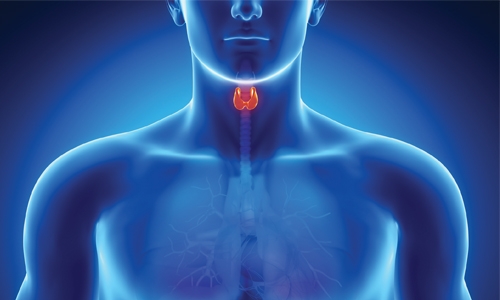Common Thyroid Problems in Bahrain
The Thyroid is the most common endocrine disorder in Bahrain and it is diagnosed late in many cases. No specific survey or a study to estimate the disease but it is roughly more than 10% of adults and it’s more in females. Most adults are now more aware of it from their family members with the disease or reading about it.
The thyroid is a gland, shaped like a butterfly, considered one of the largest endocrine glands in the body, and rests in the middle of the lower neck. Its primary function is to control the body’s metabolism. The thyroid gland produces hormones that influence essentially every organ, tissue and cell in the body. If left untreated, thyroid disease can cause elevated cholesterol levels and subsequent heart disease, infertility, muscle weakness, osteoporosis and weight problems.
The thyroid gland is prone to several distinct problems, some of which are extremely common. These problems can be broken down into those concerning the production of hormone (too much, or too little), those due to increased growth of the thyroid causing compression of important neck structures or simply appearing as a mass in the neck, the formation of nodules or lumps within the thyroid which are worrisome for the presence of thyroid cancer.
When the thyroid produces too much hormone, the body uses energy faster than it should. This condition is called hyperthyroidism. When the thyroid doesn’t produce enough hormones, the body uses energy slower than it should. This condition is called hypothyroidism.
Thyroid disease can be difficult to diagnose because symptoms are easily confused with other conditions. Fortunately, there is a blood test that can identify thyroid disorders even before the onset of symptoms. When thyroid disease is caught early, treatment can control the disorder even before the onset of symptoms. Thyroid diseases could be life-long conditions but with careful management, people with thyroid disease can live healthy, normal lives.
Underactive Thyroid Gland (hypothyroidism)
Common symptoms of the condition include tiredness, lack of concentration and forgetfulness, muscle aches, constipation, dryness of the skin, dry coarse hair, weight gain and heavy menstrual periods. Also, slow heart rate, intolerance to cold, puffiness around the eyes may also occur. In children, growth may be delayed. In some people, the thyroid gland may be enlarged.
Thyroid hormone is important for women to get pregnant, as well is important for the fetus development especially in the first 3 months. Pregnancy is perfectly safe in women who are on stable thyroid hormone replacement. However, regular medical checks during pregnancy are important because of the possible increase in dose. It is most important that treatment should be continued, especially early in pregnancy.
Overactive Thyroid Gland (Hyperthyroidism)
The clinical names for an overactive thyroid gland are: hyperthyroidism (excess of thyroid) but Graves’ disease is the commonest form of the disease. It may run in families and can occur at any age. It is seen in women eight times more often than men.
Symptoms do not generally come all at once. The symptoms and signs are due to the effects of excess amounts of thyroid hormone on body function and metabolism. In simple terms, all the metabolic processes are “speeded up”; for example, the pulse rate is rapid (over 100), bowel function is increased (diarrhoea), and the sweat glands work excessively. The nervous system is also stimulated so that the patient becomes irritable and nervous. Other common symptoms include muscle weakness, hand tremors, weight loss, sleep disturbances, enlarged thyroid gland, and infrequent scant menstrual periods. Vision problems, eye irritation, and bulging eyes, heat intolerance and frequent bowel movements happen. This may happen during pregnancy and could affect the outcome of pregnancy.
Thyroid Nodules
A thyroid “nodule” is a localized swelling within the thyroid gland. Of most concern is a single swelling, but sometimes it is part of a multiple nodule in a large thyroid. Nodules are common and often cause no symptoms. Using ultrasound of the neck, it is estimated that 40-50 % of middle people may have thyroid nodule without knowing. It is important to diagnose those nodules that may be malignant.
Thyroid nodules are usually small and painless. Most patients do not even notice the swelling. Their doctors find the swelling when they have routine medical checkups or are examined for other conditions.
However, physical examination alone cannot suffice to distinguish between benign and malignant nodules. One of the most important tests for nodules is the ultrasound, which determines size, shape, and solidity. The next step is to carry out a fine needle biopsy of the thyroid nodule. Cells and fluid are removed from the thyroid gland and examined by a pathologist to determine whether this is benign or malignant.
Thyroid cancer
Thyroid cancer is uncommon but the incidence appears to be increasing by 4% per year. It is still currently the eighth commonest cancer in the USA but more importantly, it is the second commonest cancer among women in some Gulf countries. Thyroid cancer is the commonest malignant endocrine tumour but comprises only about 1% of all malignancies. In the time period between 1973 and 1997, the incidence of thyroid cancer is increased by 50% and the rise continues. It is believed that screenings and awareness campaigns are the cause of the rise. Diagnosis depends on cytological evaluation by aspirating some cells by a small needle.
Related Posts


